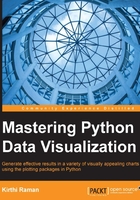
What this book covers
Chapter 1, A Conceptual Framework for Data Visualization, expounds that data visualization should actually be referred to as "the visualization of information for knowledge inference". This chapter covers the framework, explaining the transition from data/information to knowledge and how meaningful representations (through logarithms, colormaps, scatterplots, correlations, and others) can make knowledge much easier to grasp.
Chapter 2, Data Analysis and Visualization, explains the importance of visualization and shows several steps in the visualization process, including several options of tools to choose from. Visualization methods have existed for a long time, and we are exposed to them very early; for instance, even young children can interpret bar charts. Interactive visualization has many strengths, and this chapter explains them with examples.
Chapter 3, Getting Started with the Python IDE, explains how you can use Anaconda from Continuum Analytics without worrying about installing each Python library individually. Anaconda has simplified packaging and deployment methods that make it easier to run the IPython notebook alongside other libraries.
Chapter 4, Numerical Computing and Interactive Plotting, covers interactive plotting methods with working examples in computational physics and applied mathematics. Some notable examples are interpolation methods, approximation, clustering, sampling, correlation, and convex optimization using SciPy.
Chapter 5, Financial and Statistical Models, explores financial engineering, which has many numerical and graphical methods that make an interesting use case to explore Python. This chapter covers stock quotes, regression analysis, the Monte Carlo algorithm, and simulation methods with examples.
Chapter 6, Statistical and Machine Learning, covers statistical methods such as linear and nonlinear regression and clustering and classification methods using numpy, scipy, matplotlib, and scikit-learn.
Chapter 7, Bioinformatics, Genetics, and Network Models, covers interesting examples such as social network and instances of directed graphs in real life, data structures that are appropriate for these problems, and network analysis. This chapter uses specific libraries such as graph-tool, NetworkX, matplotlib, scipy, and numpy.
Chapter 8, Advanced Visualization, covers simulation methods and examples of signal processing to show several visualization methods. Here, we also have a comparison of other advanced tools out there, such as Julia and D3.js.
Appendix, Go Forth and Explore Visualization, gives an overview of conda and lists out various Python libraries.